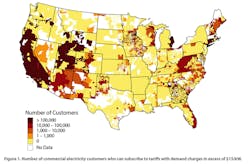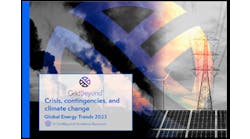If you’ve heard that energy storage can reduce what you pay in demand charges, and you’re wondering if it would work for your operation, check out a paper issued today by the National Renewable Energy Laboratory (NREL) and Clean Energy Group (CEG).
The paper finds that 25 percent of commercial customers in the U.S. – five million – pay demand charge rates of more than $15/kW, a threshold that may justify investment in energy storage.
“With this analysis, we have identified the areas where customers have the greatest potential to benefit from investments in battery storage. Utilities know where these opportunities exist, and now the rest of us have that information too,” said Seth Mullendore, co-author of “Identifying Potential Markets for Behind-the-Meter Battery Energy Storage: A Survey of U.S. Demand Charges,” and a CEG project director.
The report notes that many customers do not fully understand how demand is measured and billed — despite the fact that demand charges often represent from 30–70 percent of a commercial electric bill.
Defining demand charges
Demand charges are a somewhat murky and daunting. Applied to commercial and industrial customers (not usually homeowners), they are typically calculated based on the point in time when wholesale prices are highest. If a company can pinpoint that 15 minutes or so and reduce its consumption, it can lower its energy bills for the billing cycle. To do so, the company must predict correctly when the grid will reach that period of peak demand and then act fast.
Battery energy storage is a particularly good tool for the task because of its flexibility; it’s relatively easy to discharge the battery so that your facility uses its energy – rather than grid power – at the right moment. On-site solar can be used to reduce demand charges too, but not if the sky is cloudy just then.
Battery software is a key factor here. Advanced platforms use what the report calls “learning algorithms” to gauge when a facility is approaching peak demand. Add solar and the management software can employ a more sophisticated demand management strategy. It may make sense to incorporate microgrid-level intelligence if more forms of distributed energy are added to the system. Or, as the paper points out, a microgrid may be warranted if the facility wants the added ability to island and secure power from its onsite resources during an outage.
Credit: “Potential Markets for Behind-the-Meter Battery Energy Storage: A Survey of U.S. Demand
Charges,” by NREL and CEG
Why do demand charges exist? They are a way to compensate utilities for ensuring that enough generation and distribution service is always available for their customers. Demand charges apportion the costs to those who use the system most.
The paper’s authors took on the mammoth task of looking at 10,000 utility tariffs, available to about 70 percent of the commercial buildings in the U.S., among them private and nonprofit businesses, community facilities, public buildings, and multifamily housing properties. The authors describe the paper as the first public analysis of the potential size of the commercial behind-the-meter battery storage market in the U.S.
Important in your state?
The paper is pertinent to commercial customers in many states — not just in states like California and New York, which are known for their pricey electricity.
“Some of the country’s highest demand charges were found to be in states not typically known for high electricity prices, such as Colorado, Nebraska, Arizona, and Georgia,” said the report.
Lew Milford, CEG president, sees demand charge management bolstering the storage market in the coming years.
“This white paper offers a road map to the state-by-state development of economically driven, behind-the-meter storage markets over the next decade,” Milford said. “Solar has proliferated in states with high volumetric utility rates in the last decade. Storage will follow a similar trajectory in states with high demand charges in the years ahead.”
Track news about microgrids and energy storage by subscribing to the Microgrid Knowledge newsletter. It’s free.







